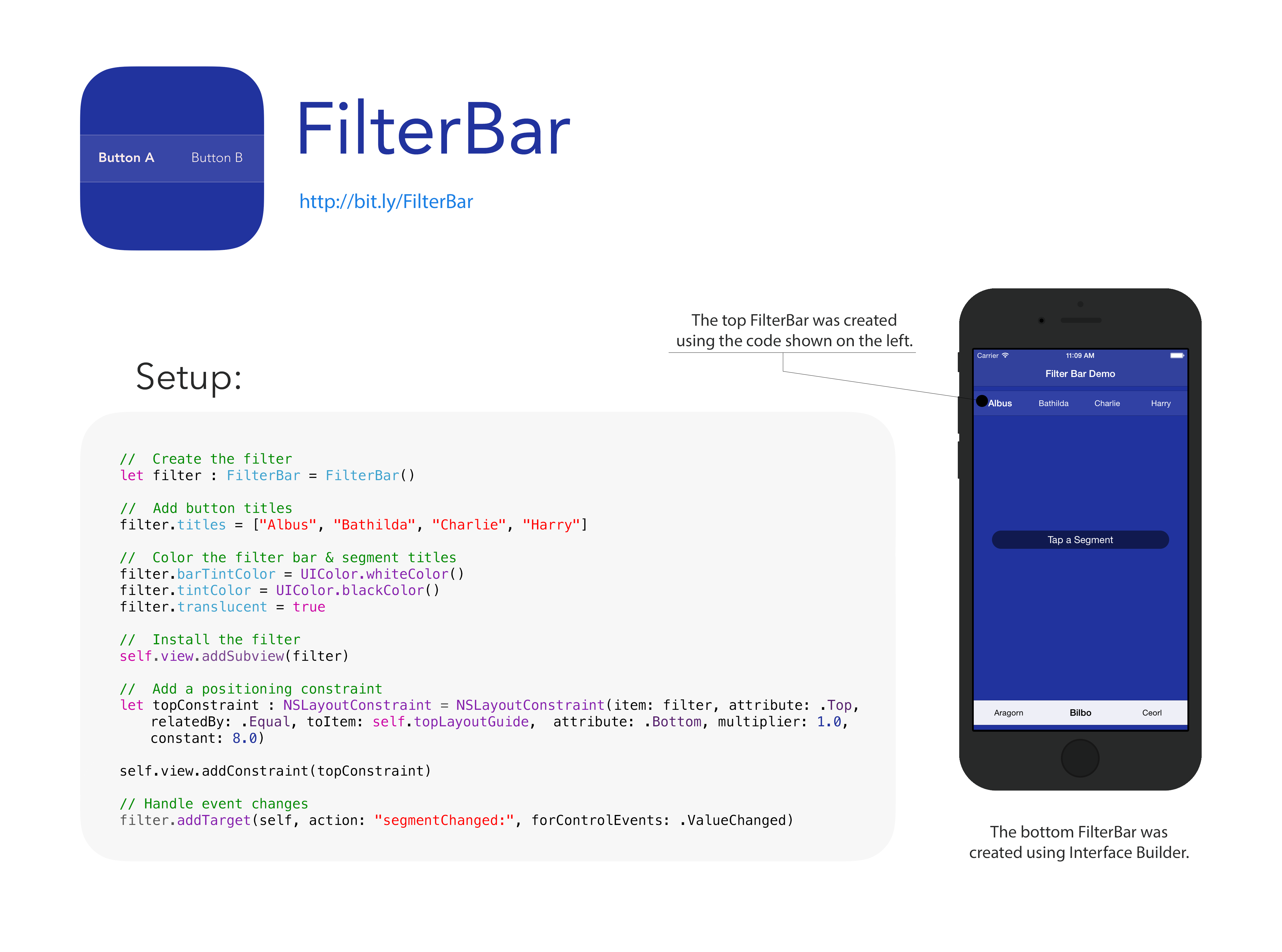FilterBar 2.0.0
| TestsTested | ✗ |
| LangLanguage | SwiftSwift |
| License | MIT |
| ReleasedLast Release | May 2015 |
| SPMSupports SPM | ✗ |
Maintained by Moshe Berman.
FilterBar 2.0.0
- By
- Moshe Berman
What happens if you combine UINavigationBar and UISegmentedControl? FilterBar.
FilterBar is a fancy implementation of UISegmentedControl that is designed to look good beneath navigation bars, search fields, and really anywhere else in your app.
It's designed to stretch across its superview and handle segment layout nicely.
Getting Started:
With CocoaPods:
pod 'FilterBar', '~>2.0.0'
Cocoapods requires iOS 8.0 or higher.
If you're supporting iOS 7, or if you prefer, you can just drop FilterBar.swift to your project.
Creating a FilterBar:
It's simple:
let filter : FilterBar = FilterBar()
That's it. We'll use our filter for the remainder of this README.
Setting the Segment Titles:
To choose what titles are shown on the filter bar, set the titles property of the filter bar. FilterBar will then trigger a layout update and automatically generate the segments. For example:
filter.titles = ["Albus", "Bathilda", "Charlie", "Harry"] // Harry Potter!
Positioning the FilterBar:
FilterBar uses an intrinsic size and a pair of layout constraints to ensure that it it always centered in and stretched across its superview. You only need to provide a Y position constraint for it.
// Create a constraint that attaches the filter bar to the top layout guide.
let topConstraint : NSLayoutConstraint = NSLayoutConstraint(item: filter, attribute: .Top, relatedBy: .Equal, toItem: self.topLayoutGuide, attribute: .Bottom, multiplier: 1.0, constant: 8.0)
// Add the constraint to the filter view.
self.view.addConstraint(topConstraint)
Every FilterBar issued from the factory calls setTranslatesAutoresizingMaskIntoConstraints on itself so you don't have to.
FilterBar Tint Color
To set the tint of the FilterBar, use barTintColor. For example:
// Color the filter bar
filter.barTintColor = UIColor.whiteColor()
This will cause the filter bar to have a white background.
Note:Previously, barTintColor was named color. The color property is deprecated. Setting the color property now sets the barTintColor property, but in future versions, color will be removed.
FilterBar Translucency
FilterBar can be opaque or translucent. Turn translucency on or off with the translucent property.
// Enable translucency
filter.translucent = true
Segment Text Color
To set the color of the text in the FilterBar's segments, use the tintColor property.
// Color the text
filter.tintColor = UIColor.whiteColor()
Border Color
FilterBar supplies a 0.5 point border that's black and transparent.
The previous version of FilterBar allowed the setting of a borderColor property. This is no longer supported, because FilterBar now mimics the appearance of UINavigationBar much more closely.
The borderColor property is deprecated, and setting it does nothing.
Getting Events:
FilterBar is a subclass of UIControl, and uses the .ValueChanged event to handle changes.
filter.addTarget(self, action: "segmentChanged:", forControlEvents: .ValueChanged)
This assumes that you have a handler called segmentChanged: that looks something like this:
func segmentChanged(sender: AnyObject) {
// Handle changes here
}
Checking which Segment is Selected:
Use the selectedSegmentIndex property.
Interface Builder Support:
FilterBar supports Interface Builder in several ways. You can set the color of the bar, and FilterBar will render a preview in interface builder.
To use FilterBar with Interface Builder, drag a UIView out on to your view (controller) and change the class to FilterBar.
License:
FilterBar is released under the MIT license. See LICENSE for details.

